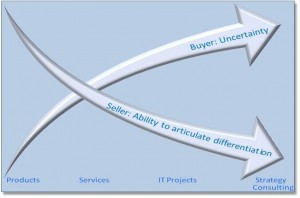All companies are trying to differentiate their products and services from those of the competition. They believe that strong differentiation is a necessary part of the business strategy to create and grow a market, because, the logic goes, if their products or services are just like the competitors’, why would the customer buy from them? How will they attract and retain buyers?
I am frequently asked to provide market assessments, conduct SWOT analyses and help companies formulate a go-to-market strategy that would differentiate their product or service offering from the competitors and tell it in a credible and compelling way. The problem is that many companies do more or less the same thing, the same way, in the same market, and that they are unable to credibly differentiate their offerings from other companies.
In an HBR article titled You Can Win Without Differentiation, Freek Vermeulen discusses the question of differentiation. Vermeulen argues that when companies are unable to differentiate their offerings effectively, the only option they have is to drop prices and hope to make up some of the loss by increased sales volume, a tactic that is easy for the competition to match. While both consumers and suppliers are very sensitive to pricing, a differentiation and competitiveness strategy based on price alone is fragile, especially when there is ample supply of competitors and substitutes. In this kind of zero-sum competitive game, the ultimate winner of price wars is the consumer.
I believe there are other options for product companies to consider before lowering prices and engage in fierce price competition. For instance, product companies should certainly compete on quality, warranty coverage, delivery terms and service levels. In this type of differentiation, the buyer can make a reasonable comparison between features, functionality, warranty terms and pricing.
However, if you sell services rather than products, this is not as straightforward. Vermeulen uses the example of management consulting firms, such as McKinsey and Accenture, where there is no simple and obvious way to articulate and differentiate their capabilities and make a succinct, credible and reliable connection between capabilities and business outcome. Furthermore, the skills, capabilities and services these firms sell are common commodities across the industry and therefore do not form an effective barrier to entry.
 When value differentiation is too vague and difficult to demonstrate, price competitiveness does not work. Potential buyers seek other ways to drive their decisions, and, as Vermeulen points out, they rely on other factors, such as the seller’s brand, status in industry, and prior relationships. In other words, the buyer switches from assessing and comparing features and costs to differentiating based on the brand’s credibility and trustworthiness.
When value differentiation is too vague and difficult to demonstrate, price competitiveness does not work. Potential buyers seek other ways to drive their decisions, and, as Vermeulen points out, they rely on other factors, such as the seller’s brand, status in industry, and prior relationships. In other words, the buyer switches from assessing and comparing features and costs to differentiating based on the brand’s credibility and trustworthiness.
This is where I see many companies, especially software and professional services vendors, struggle. It appears to be especially painful for companies transitioning from providing a general set of enterprise IT tools and services and wanting to ride the momentum of new technologies such as cloud computing, big data and mobility, and apply them task-specific functions in vertical industries.
Establishing credibility in vertical markets can be difficult. The buyer’s functional leadership and the employees need to have trust in the vendor to have deep understanding of their process and appreciation of the subtleties of day to day operation.
So here are some suggestions:
Don’t
- Don’t assume that your experience and tools can be easily transformed from one business segment to another. Some do; most don’t. Take the time to develop a detailed credible business case that you can deliver.
- Don’t oversell technical wizardry. Buyers of enterprise software and services consider your product roadmap and long-term commitment to the space as much as they do to your product features and engineering skills.
- Don’t try to prove industry knowledge and demonstrate empathy by highlighting the industry’s poor performance which you are going to turn around over night. Your audience already knows this all too well. Focus on the solutions.
Do
- Develop deep expertise and position in your target industries and business functions. Not through “desk research” and generic stories, but rather by demonstrating successful implementations, publicizing customer case studies that are real, specific and credible, and becoming an industry insider.
- Focus on establishing and nurturing long-term strategic relationships with your key customers.
- Seek partnerships with systems integrators and service providers, especially in industries that are complex and narrowly focused, as these often have a culture that is difficult for outsiders to penetrate.
One last parting thought. The strategy you use to define and demonstrate your company’s differentiation to potential buyers is not necessarily the one you discuss with Wall Street and industry analysts. This is a subject for a future blog post. In the interim, you can review another HBR article by Todd Zenger: Strategy: The Uniqueness Challenge.
Further Reading:
- You Can Win Without Differentiation by Freek Vermeulen, Harvard Business Review Blog, October 2013
- Strategy: The Uniqueness Challenge by Todd Zenger, Harvard Business Review, November 2013
- The Five Competitive Forces That Shape Strategy by Michael Porter, Harvard Business Review, January 2008
